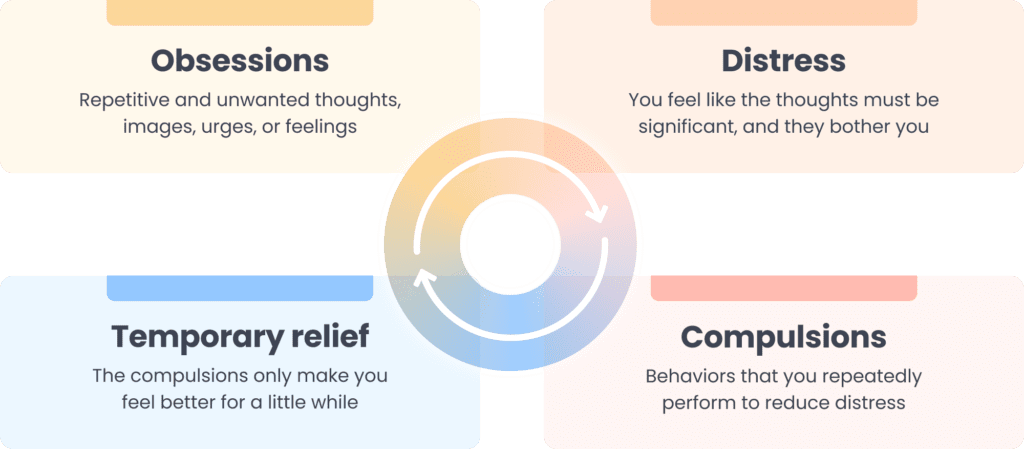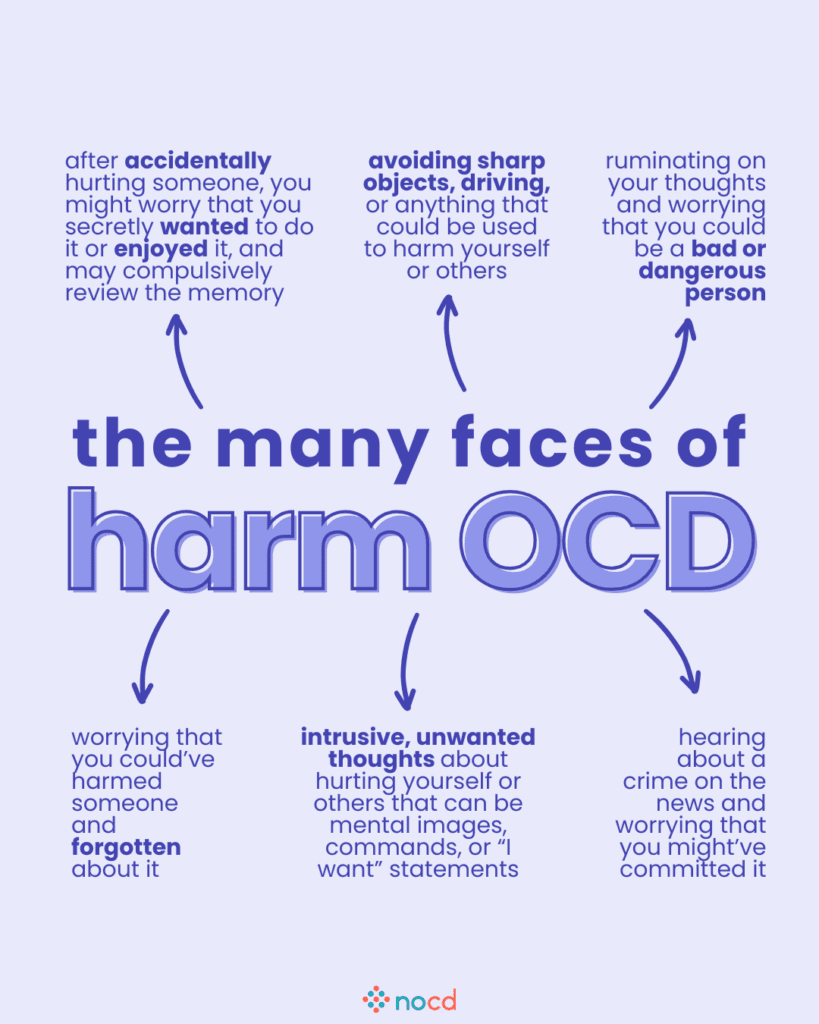Harm OCD is a subtype of obsessive-compulsive disorder (OCD) where people experience intrusive thoughts about causing harm to themselves or others. These thoughts are unwanted, distressing, and often go against the person’s values, leading to intense fear, shame, and guilt.
It’s important to understand that having harm-related intrusive thoughts doesn’t mean you’re dangerous. Harm OCD is very common, with research showing that 31.8% of people report that they’ve had harm-related obsessions.
What is harm OCD?
Harm OCD is a form of OCD centered around fears of causing harm. These fears can involve:
- Hurting a loved one, a stranger, or yourself
- Failing to prevent harm from happening
- Acting violently or impulsively, even when you don’t want to
“Although it might sound surprising, it is relatively common to have a thought, impulse, or urge to harm oneself or someone else,” says Patrick McGrath, PhD, NOCD’s Chief Clinical Officer.
People with harm OCD often engage in compulsions—repetitive physical or mental acts—to reduce distress from intrusive thoughts or to prevent something bad from occurring. These can include reassurance-seeking, mental reviewing, avoiding situations that feel dangerous, or checking for signs of harm.
What are the symptoms of harm OCD?
Harm OCD symptoms follow the same cycle of obsessions and compulsions as other subtypes.
Obsessions (intrusive thoughts, images, urges, sensations, and feelings)
- What if I stab someone while cooking?
- What if I lose control and hurt my baby?
- What if I accidentally run someone over with my car?
- What if I poison my partner’s food by mistake?
These obsessive thoughts are unwanted and cause significant distress.
Compulsions (repetitive physical or mental actions done to relieve distress and/or feel safe)
- Avoiding sharp objects or places where others could be harmed
- Mentally reviewing your actions to be sure you didn’t hurt anyone
- Seeking reassurance from loved ones (Did I do something bad?)
- Monitoring your feelings or checking for urges to harm
These behaviors may bring temporary relief, but, ultimately, they end up reinforcing the OCD cycle, making your symptoms worse over time.

Does having harm OCD mean you’re dangerous?
No. People with harm OCD are not more likely to hurt others.
The thoughts you experience are intrusive and ego-dystonic—meaning they go against your values—which is why they cause so much distress. Many people with harm OCD actually go to extreme lengths to avoid causing harm, which can lead to isolation or constant checking behaviors.
What triggers harm OCD thoughts?
Harm OCD thoughts can be triggered by everyday situations, such as:
- Being near sharp objects
- Driving a car
- Holding a baby or pet
- Reading or watching news about violence
- Stressful life events
Sometimes, thoughts feel like they “come out of nowhere.” This unpredictability can make people feel even more anxious and on edge.
How is harm OCD diagnosed?
There’s no single test for harm OCD. A trained mental health professional can diagnose OCD based on:
- The presence of obsessions (intrusive thoughts, images, urges, feelings, or sensations)
- Physical or mental compulsions that take up an hour or more of your day
- The impact of these symptoms on your daily life
If you suspect you have harm OCD, reach out to a mental health professional who specializes in OCD.
How is harm OCD treated?
The most effective treatment for harm OCD is exposure and response prevention (ERP) therapy. ERP is a specialized form of cognitive behavioral therapy (CBT) proven to be effective for OCD. General CBT, if not tailored for OCD, can sometimes be unhelpful or even worsen symptoms.
- In ERP, you gradually face feared thoughts and situations (exposures) while resisting the urge to perform compulsions (response prevention).
- Research shows that ERP therapy is effective for 80% of people with OCD.
- Medication (SSRIs) can also help reduce moderate to severe OCD symptoms for some people, especially when combined with ERP therapy.
Other supportive options, such as acceptance and commitment therapy (ACT), mindfulness-based strategies, and psychoeducation (learning about OCD and how it works), can complement ERP therapy.
More intensive treatments, such as intensive outpatient programs (IOPs), partial hospital programs (PHP), transcranial magnetic stimulation (TMS), deep brain stimulation (DBS), and gamma knife radiosurgery (GKRS), may be recommended for severe, treatment-resistant harm OCD.
Find the right OCD therapist for you
All our therapists are licensed and trained in exposure and response prevention therapy (ERP), the gold standard treatment for OCD.
Can you recover from harm OCD?
Yes. With treatment, people with harm OCD can regain control of their lives. ERP therapy helps you break the cycle of fear and compulsion, allowing intrusive thoughts to lose their power over time.
Let’s be clear—recovery doesn’t mean you’ll never have another intrusive thought—everyone has them. Instead, you’ll learn how to respond to them in a healthier way, so they no longer dominate your life.
When to seek help
If harm-related intrusive thoughts are affecting your daily life, relationships, or sense of safety, it’s time to reach out for professional help.
Below are some signs you might benefit from talking with an OCD specialist:
- You’re avoiding people, places, or objects out of fear that you might cause harm.
- You spend a lot of time replaying events in your head to make sure nothing bad happened.
- You feel intense guilt, shame, or fear about your thoughts.
- You’re engaging in compulsions that are taking up a lot of time each day.
- You feel stuck in a cycle of anxiety and can’t break free on your own.
With the right care, it is possible to stop the cycle and take back your life.
FAQs about harm OCD
Not exactly. While harm OCD involves intrusive thoughts about harm or violence, these thoughts are unwanted and cause distress. People with harm OCD fear acting on these thoughts, which is the opposite of intent.
No. Having intrusive thoughts doesn’t make you more likely to act on them. In fact, people with harm OCD are extremely unlikely to harm others.
Yes. Harm OCD can affect people of all ages, including children and teenagers. Early diagnosis and treatment can make a big difference.
Medication, particularly SSRIs, can reduce OCD symptoms for many people and may be used alongside ERP therapy.
Bottom line
Harm OCD can feel isolating and frightening, but it’s important to remember that you’re not dangerous, nor are you alone. These thoughts are a symptom of OCD, not a reflection of who you are. With the right treatment, especially therapies like ERP (and medication when appropriate), you can break the cycle of fear and regain confidence in yourself and your life.
Key takeaways
- Harm OCD is a common subtype of OCD where intrusive thoughts focus on causing harm to yourself or others, but these thoughts do not reflect your true intentions.
- Having harm-related thoughts does not make you dangerous—people with harm OCD are actually less likely to act on these thoughts.
- Effective treatments are available, including exposure and response prevention (ERP) therapy, ACT, medication, and other supportive approaches tailored to your needs.


